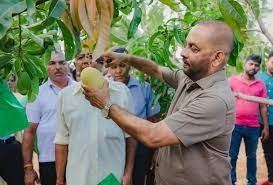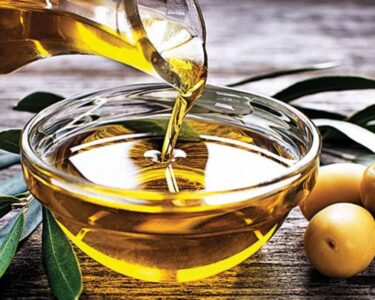Sri Lanka’s mango trees are bursting with fruit this year, but the record-breaking harvest has Agriculture Minister Mahinda Amaraweera scratching his head. While a bountiful mango season is usually cause for celebration, this year’s surplus has triggered concerns about a price plunge that could hurt farmers. Instead of seeking export avenues, the Minister’s focus is on a crucial question: should mango cultivation be scaled back in the future?

Sweet Dilemma:
• This year’s mango haul surpassed the usual 250 million fruits, thanks to a unique weather pattern.
• While it’s a feast for the senses, the abundance has driven down prices by nearly half, impacting farmer incomes.
• The worry is that uncontrolled expansion could lead to similar gluts in the future, further jeopardizing livelihoods.
Minister’s Inquiry:
• Amaraweera has requested a scientific report from the Department of Agriculture to assess the sustainability of further mango cultivation.
• The report will analyze market trends, price fluctuations, and land usage patterns to determine optimal cultivation levels.
• It will also consider the impact on farmer income, resource utilization, and the environment.
Expanding Global Market:
The global market is expanding and Sri Lanka needs to explore avenues to exploit export potential instead of curtailing production, said Indian Agronomist Aravind Chandra Mohan.
The TEJC variety has great export potential . According to data from the National Institute of Post Harvest Management (NIPHM), under the Ministry of Agriculture, the annual mango harvest for all varieties in the country typically amounts to around 250 million fruits
This surplus in production resulting in a drop in the price of TEJC mangoes, needs to be seen as a temporary issue coupled with the inability of the Sri Lankan authorities to get more export orders said Aravind Chadra Mohan.
The fruit is a rich source of nutrients and vitamins and is widely consumed in fresh, frozen and canned forms. The increasing applications of mango in the beverage industry and processing and confectionery items are expected to drive the demand for the global mango market. However, seasonal availability and high pest and disease attacks may hamper the market growth.

Global Mango Market Dynamics:
Data Bridge Market Research analyses that the global mango market will grow at a CAGR of 4.9% from 2023 to 2030.
The mango tree is native to southern Asia, particularly Myanmar and India’s Assam state and various cultivars have been developed. Mangos are high in vitamins A, C and D.
The major factor likely to support the growth of the global mango market is the increased product demand from the beverage industry in the upcoming years. Various large-scale food and beverage producers have introduced products based on mango into the market, such as Starbucks, McDonald’s and PepsiCo, among others. These brands largely use fruit extracts and purees in their smoothies and drinks. These drinks are in great demand among consumers, likely to leverage the mango market in the future positively.
Moreover, mango-based drinks are back with compelling commercials on television, peddling the belief that they are all you need to quench your thirst in a day. Much like the fruit itself, Mango-based drinks are expected to be in high demand. In addition, there are several mango-flavored drinks in the market like maaza, frooti and slice, which have a large market share in various countries.
High demand for mango puree owing to growing awareness regarding the use of organic products
Mango puree, often called mango pulp, is a smooth and thick product processed so that the insoluble fibrous parts of the ripe mangoes are broken up. It retains all fruit juice and a huge portion of the fibrous matter naturally, which is found naturally in raw fruit. Organic mango puree is in higher demand by consumers due to growing awareness regarding the usage of organic products.
The United Arab Emirates was the main destination for mango exports from Sri Lanka, while Qatar and the Maldives followed.
Colombo-based fruit and vegetable suppliers point out that if proper measures are put in place Sri Lanka could double its mango exports by just concentrating on these three destinations alone, while the European and USA markets have been hardly touched by Sri Lankan Mango exporters.







